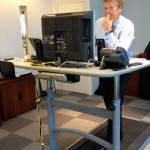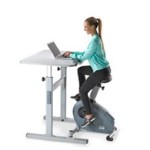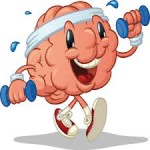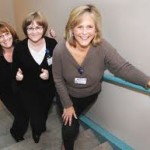Active workstations’ make fitness part of the job
By Julia Savacool , July 6, 2015
(USA Today) In a country plagued by obesity, any effort at intervention should be applauded. And so, a growing number of companies are outfitting their offices with “active” workstations — treadmills, bikes and elliptical trainers that have been reconfigured to allow users to move, talk and type simultaneously.
But just how effective are these devices? What do the data show about office treadmilling vs., say, an hour at the gym?
That’s the wrong question to ask, says Michael Sliter, an occupational health researcher at FurstPerson in Chicago and author of a new study investigating the benefits of in-office physical activity.
“These machines are not supposed to be in lieu of aerobic exercise,” he says. “They are meant to be an alternative to sedentary lifestyles.” That’s not a matter of semantics: Independent of exercise and diet, studies show that sedentary living carries with it a host of alarming health problems. “Sitting disease,” steadily on the rise in America as technology has put the world at our fingertips rather than our feet, is blamed for everything from an increase in cardiovascular disease to higher blood pressure and shorter lifespans. In fact, a study in the journal Medicine & Science in Sports and & Exercise found that those who spend the majority of their day seated have a 54% higher risk of dying from a heart attack than those with more physical jobs.
Enter active workstations. “With these machines, you are putting out 1.7 to 2.5 METs (measurements of energy output), or about double your resting metabolism,” says Christoph Leonhard, professor of clinical psychology at Xavier University of Louisianaand creator of the activeLife Trainer, a seated elliptical-style machine that can fit beneath a desk. “You are working at 60% of your maximum heart rate, enough to take you out of the sedentary category and allow people to avoid the health risks of being inactive,” but not so strenuous that you break a sweat in your work clothes.
As for the weight-loss benefits of these workstations, it may be greater than you think — provided you think long-term. Any movement burns more calories than non-movement, of course, and in the case of office treadmills, workers in a study in theBritish Journal of Sports Medicine who walked at a pace of 1 to 2 mph (a very leisurely stroll) burned roughly 100 calories an hour more than those who remain seated at a desk. Over the course of the day, treadmill users walked for about three hours total, burning 300 calories more than their inactive counterparts. Though not a huge amount, the cumulative effect can be powerful: Shedding 1 pound requires a 3,500-calorie deficit, which was achieved in this study in about 12 days. After about a month of office treadmill use (excluding weekends), people could feasibly lose 2 pounds without changing their diet or going to the gym. That averages out to 24 pounds a year—enough to matter to most people.
Perhaps the least-considered variable, however, is the effect of active workstations on an employee’s mental state. After all, joggers famously clamor for that “runner’s high,” and plenty of research has linked cardio activity with feelings of energy and euphoria. Does that translate to slow strolls on a treadmill or pedaling on a stationary bike?
“We all know that if you exercise, you feel better, and if you feel better, you tend to perform better as well,” Sliter says. In his study, published in the Journal of Occupational Health Psychology, Sliter measured feelings of boredom and job satisfaction among workers who used an active workstation vs. those who did not. He found that users of active workstations, particularly those on treadmills, were more likely to feel satisfied and less bored, something possibly attributable to the fact that working while walking is a multitasking enterprise that requires focus and concentration.
Sliter’s study isn’t the only one to find surprising perks beyond health and weight loss for those who use these devices. Researchers from the Carlson School of Management at the University of Minnesota followed the progress of a group of office treadmill walkers versus non-walkers for an entire year. They found that the walkers consistently showed greater productivity and higher work quality, possibly because of the known ability of exercise to increase blood flow to the brain.
If you want to give the trend a try (and your company is amenable), the question is: Which device to use? Choosing one type of machine over another may come down to personal preference. Says Leonhard, “Some studies suggest a difficulty with eye-hand coordination when you are on a treadmill because the whole body is in motion. With the seated machine, you have more control over your upper-body movements to use a mouse or type.”
As for the boost in job performance, Leonhard believes it may be as straightforward as this: “You are essentially tied to your machine,” he says. “Where you used to take a break from your chair, get up, walk to the bathroom, and stretch your legs, now there is no incentive to leave your workspace, so you accomplish more. People know they are doing something good for themselves, and that itself motivates them to continue.”
Getting Busy on the Job
Active workstations can set you or your company back by several thousand dollars per device. For a jolt of office energy, no treadmill required, check out these cheaper alternatives.
Stand up
The cost of a stand-up desk is a fraction of cardio equipment but can still increase on-the-job performance, according to a recent study in the International Journal of Obesity.
Sit unsupported
While some research suggests those fitness ball chairs are ultimately duds as body toners and calorie burners, you will still gain an incremental increase in energy expenditure from using them. That is, of course, assuming you don’t fall off.
 Take a real walk
Take a real walk
Before the days of email, texting, computer printers and, heck, even telephones, colleagues shared information by — get this — actually walking down the hall to the other person’s office. Give it a try! Once an hour, step away from your desk and go for a short stroll — to the bathroom, the water cooler or a co-worker’s cubicle.
 Discover the stairwell
Discover the stairwell
You’ve heard it before: Take the stairs instead of the elevator to burn extra calories. A 10-minute climb up and down the stairs will burn about 100 calories. Do it in the morning, at lunchtime and on your way home and you’ll match the energy output of three hours on an office treadmill.



